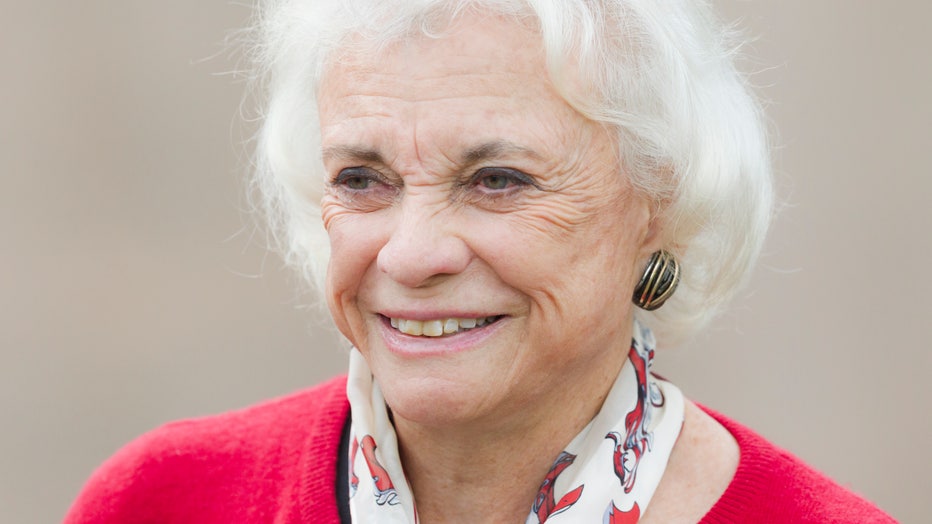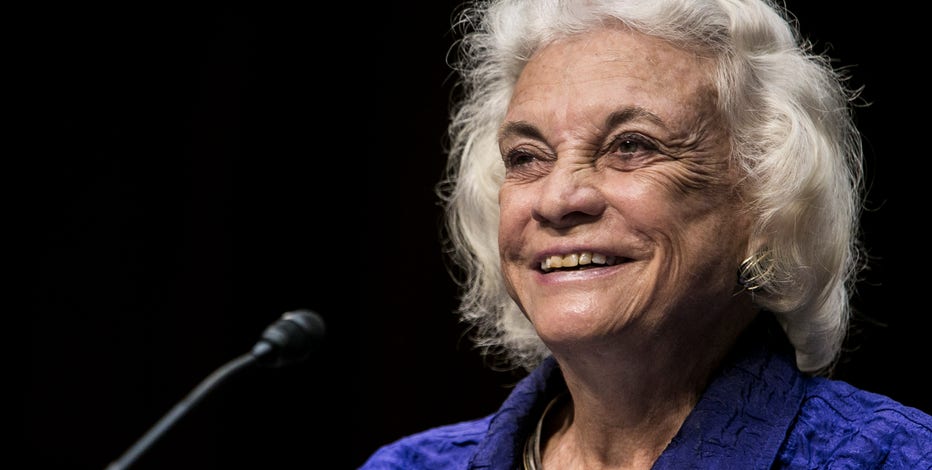Former U.S. Supreme Court Justice Sandra Day O'Connor has died
PHOENIX - The Supreme Court says retired Justice Sandra Day O'Connor, the first woman on the high court, has died at age 93.
According to a statement by Supreme Court officials, O'Connor died in Phoenix due to complications related to advanced dementia and a respiratory illness.
"A daughter of the American Southwest, Sandra Day O’Connor blazed an historic trail as our Nation’s first female Justice. She met that challenge with undaunted determination, indisputable ability, and engaging candor. We at the Supreme Court mourn the loss of a beloved colleague, a fiercely independent defender of the rule of law, and an eloquent advocate for civics education, and we celebrate her enduring legacy as a true public servant and patriot," wrote Supreme Court Chief Justice John Roberts.
Born in Texas, raised in Arizona
Featured
Sandra Day O'Connor: Arizona leaders remember nation's 1st female Supreme Court justice
Current and former political leaders in Arizona are remembering the life and legacy of Sandra Day O'Connor, an Arizona who became the first woman to serve as a U.S. Supreme Court justice.
The woman who would one day sit on America's highest court started out as a cowgirl.
Born in El Paso, Texas on March 26, 1930, O'Connor grew up on her family's cattle ranch, called The Lazy B, in Duncan, Ariz. The town is located in Greenlee County, near the Arizona-New Mexico State Line.
A number of years ago, O'Connor wrote a book about her childhood. Sandra Day, as O'Connor was known back then, lived the Western life many people saw on TV and movies, or read about in a book.
"It was a large cattle ranch, and you had things to do everyday. It was something different. Sometimes, it was moving some cattle from Point A to Point B for a reason, to different water source, one pasture to another," said O'Connor.
A difficult start to her legal career
A rancher's daughter, O'Connor was a brilliant student who excelled in high school in El Paso, and then at Stanford University as an undergraduate, and at Stanford Law School, where she graduated third in her class in 1952. That same year, O'Connor and her husband, John Jay O'Connor III, were married, and O'Connor was ready to dive into the legal world.
There was one problem, however: no one would take O'Connor seriously at the time, because she was a woman.
"I went looking, and there were maybe 40 notices on Stanford's bulletin board that said give us a call," O'Connor recounted. "I called every phone number on that list. Not a single firm would talk to me. I was a woman. They said we don't hire women. I mean, I could not get an interview from that phone call list."
Eventually, O'Connor found work as a Deputy County Attorney in San Mateo, Calif. The O'Connors later moved to Phoenix, where they raised three boys: Scott, Brian and Jay.
Her time in the political and legal arena
In 1965, O'Connor became an Assistant Arizona Attorney General, and in 1969, she was appointed to the Arizona State Senate when the State Senator from her district resigned.
O'Connor won election to the State Senate in 1970, and again in 1972. She also served as the Republican Party majority leader, the first woman to hold that position anywhere in the country.
In 1974, O'Connor left the State Senate, and became a Superior Court Judge in Maricopa County. Five years later, Democratic Governor Bruce Babbitt appointed O'Connor to the Arizona Court of Appeals.
A decades-long Supreme Court career
In 1981, Republican President Ronald Reagan nominated O'Connor to be the first woman justice on the U.S. Supreme Court. The senate confirmed her unanimously.
Ruth McGregor, who served as Chief Justice of the Arizona Supreme Court, was a law clerk for O'Connor during her first term as a Supreme Court Associate Justice.
"People watched everything," McGregor recounted. "The car she drove, the menu when she had dinner. Where she shopped, they watched. Every single part of her life, she was under constant scrutiny. Always gracious and kind to people."
O'Connor would spend nearly a quarter of a century (24 years, to be exact) on the nation's highest court. She came in with solid conservative credentials, and carved out a role as a pragmatic jurist who decided each case on the merits.
"I have one of nine votes here. Sometimes I am in the majority, sometimes I am in the dissent. I don't see my role as deciding all these things," said O'Connor.
Paul Bender has argued a number of cases before O'Connor in the U.S. Supreme Court. He is a professor at the ASU school that bears O'Connor's name: the Sandra Day O'Connor College of Law.
"If you had to pick somebody to be the first woman on the Supreme Court, it would be hard to think of anyone who would have served that role any better than Justice O'Connor," Bender said. "Well respected by everybody of all political stripes. She did a really good job on the court in addressing issues in a sensible, pragmatic way."
O'Connor retired from the court in 2006 to take care of her husband. By then, he was suffering from Alzheimer's Disease, and John Jay O'Connor III died in 2009.
After O'Connor left the court, she remained active for some time, writing and speaking and serving the public.
O'Connor left a clear legacy
The former dean of the Sandra Day O'Connor College of Law, Doug Sylvester, said O'Connor's legacy is clear.
"She is the most important woman in the history of the United States," said Sylvester. "That is true today, and will be true for a long period of time, and I think that is quite a legacy."
To women attorneys, O'Connor was a role model in the very best way.
"I think that one of the things I love about Sandra Day O'Connor is that she did what she thought was right," said Paige Martin, former president of the Arizona Women Lawyers Association. "She wasn't necessarily married to politics when she was on the court. She made the decision she thought was the right decision, and I think that is what our judiciary should do."
Since O'Connor was appointed to the Supreme Court, there has been a continuous presence of female justices at the court. O'Connor's appointment was followed by that of Ruth Bader Ginsburg in 1993. Ginsburg passed away in 2020, while she was still on the bench. Currently, there are four women on the Supreme Court bench: Amy Coney Barrett, Ketanji Brown Jackson, Elena Kagan, and Sonia Sotomayor. Kagan and Sotomayor were appointed in the late 2000s, while Coney Barrett and Brown Jackson were appointed in the 2020s.
Besides ASU's law school, the federal courthouse in Downtown Phoenix is also named after O'Connor, along with a high school in Northwest Phoenix.
In addition, the O'Connors' old home in Paradise Valley was taken apart and reassembled in Tempe's Papago Park, and it now serves as a place for leaders with different viewpoints to meet to find common ground, a living monument to her life and work.
According to the statement, O'Connor is survived by her brother, three sons, as well as six grandchildren.

Former Supreme Court Justice Sandra Day OConnor (Photo by David Madison/Getty Images)


